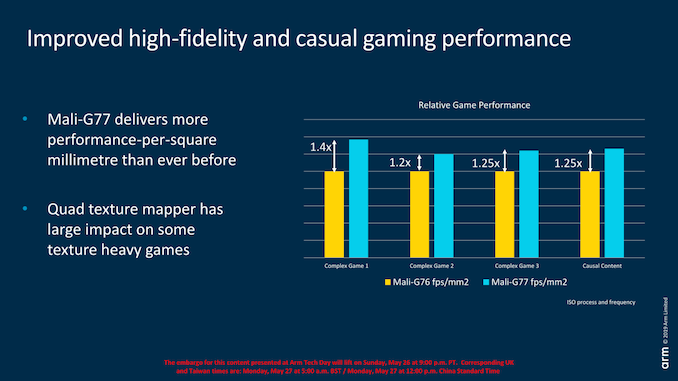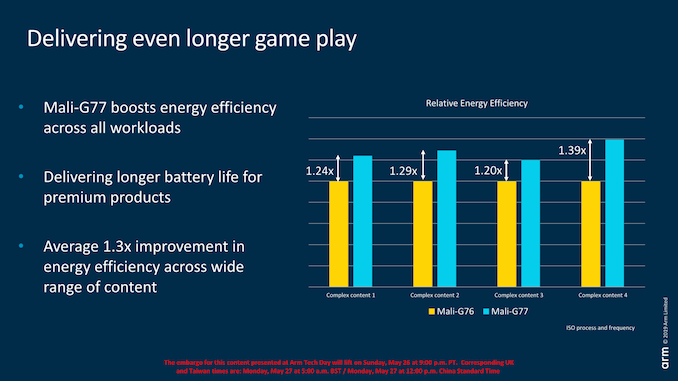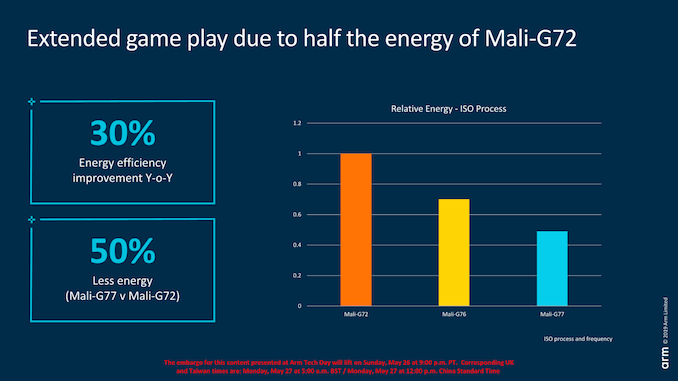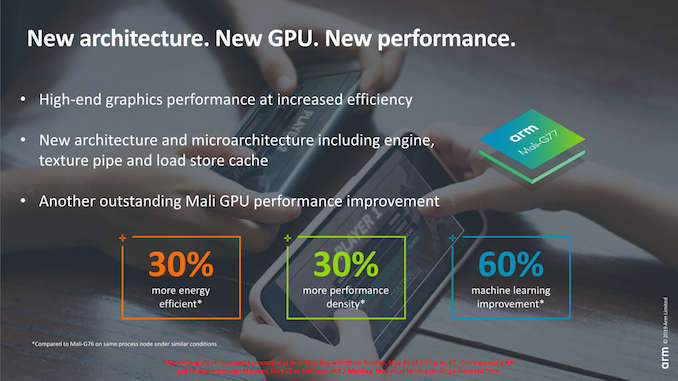Arm's New Mali-G77 & Valhall GPU Architecture: A Major Leap
by Andrei Frumusanu on May 27, 2019 12:00 AM ESTPerformance Targets: 30% Better PPC and Efficiency
On paper, the new Valhall architecture and the new Mali-G77 certainly seem like big changes, but what will be more important is to see what the performance, efficiency, and area claims are.
Arm’s performance claims are interesting because they’re being published in a performance per mm² basis. Due to how vendors implement their GPUs, in which they can vary core count as well as frequency, it’s hard to actually give a clear figure which describes the improvements between two discrete GPU configurations. In the case of the G77, Arm claims that the new IP is able to provide from 1.2x to 1.4x the performance/mm² compared to the G76. In absolute terms a G77 shader core is said to be about the same size as a G76 core.
What this means is that this could be directly translated into either a smaller GPU for the vendor, or simply more space to add in additional GPU cores and consequently increase the performance. Particularly Arm claims the G77 does very well in texture heavy games, so that will be something interesting to see in once devices actually come out and how different workloads will behave.
Another way to increase performance is to clock the GPU higher. Here the fundamental limit is the 4-5W TDP thermal envelope of smartphones. In a comparison at ISO-process and performance, the new G77 is said to use between 17% and 29% less energy and power to complete the same workloads. Or in other words, the performance/W is 1.2x to 1.39x better. Arm states that fundamentally frequency between the G76 and G77 shouldn’t change much at all, an internally Arm still targets and 850MHz sign-off.
This year I’m not going to attempt any performance and efficiency projections as there’s just too many variables at play. Among one of the larger changes for next year is that I’m expecting SoCs to support LPDDR5 which likely will change the power dynamics in smartphones by some notable margin.
Arm does note that they are expecting 1.4x performance jumps in next year’s SoCs with the G77. Using Samsung’s Exynos 9820 as the reference G76 implementation, this would mean that a future G77 SoC would come close with Apple’s A12 GPU’s performance at better power efficiency (assuming power levels are maintained). This would put Qualcomm in trouble as it would be a clear jump ahead of the current generation Adreno 640, however we expect Qualcomm to follow-up with a new generation GPU as well.
Machine learning performance of the G77 is something that Arm is quite proud of. Here it’s not just the fact that the cores have 33% more processing units, but also the much improved design of the LSC and its bandwidth that pushes inferencing performance of the G77 at an average of 1.6x the G76.
Finally, Arm made a generational comparison between the last two generation Mali GPUs. On the same process and at the same performance, the new G77 continues on track to 30% year-on-year energy efficiency improvements, and uses 50% less energy than a Mali-G72.
Conclusion & End Remarks
During the TechDay event Arm was clearly very excited about the new Valhall architecture and the new Mali-G77. There’s very much reason to be excited as it seems like Arm is about to showcase a significant generational jump in its Mali GPU IP.
The new G77 employs a brand-new architecture that fundamentally revamps Arm’s execution core, aiming for something more modern and in line with desktop GPU architectures. This seems like a shift that was long coming, as while the G76 was a relatively good GPU, the previous generation G72 and G71 weren’t.
I’m expecting to see the Mali-G77 in the next generation of Samsung Exynos and HiSilicon Kirin SoCs later this year and early next year. On paper and if everything goes right, the G77 should be able to close the performance and efficiency gap to Apple and Qualcomm. In particular the G77 should be able to leap ahead of Qualcomm’s Adreno GPUs, that is, at least against the current-generation.
I’m fairly optimistic, and now Arm as well as the partner licensees just need to execute properly for users to be able to enjoy the end-results.















42 Comments
View All Comments
eastcoast_pete - Wednesday, May 29, 2019 - link
Addition: Unless MS did reach out to ARM and ARM said no. If that's the case, that would be worth an article or two!Andrei Frumusanu - Friday, May 31, 2019 - link
Arm is open to Windows drivers but their official stance right now is to have Qualcomm take the lead. Demand is mostly based on the other chip-makers going into that market (HiSilicon, Samsung).darkich - Tuesday, May 28, 2019 - link
.. except that Intel's low power chips actually are that bad in graphics processing that they get easily trounced even by current gen phone GPU's, including the Mali ones. Get some cluejackthepumpkinking6sic6 - Monday, June 3, 2019 - link
And their latest in laptop chips... Well at least up to most 8th gen I think... Barely had any power or efficiency gains even over the 4000 series. Like i7 4800. In fact had more power than even most 7000 series ones. Well better bench scores.jjj - Monday, May 27, 2019 - link
They really need to push on the GPU side as foldables somewhat double pixel count and in theory, double fold or rollable can go even further. Larger screens do make mobile gaming more appealing so it's good for everybody.PeeCee - Thursday, May 30, 2019 - link
Exynos 9830 should incorporate Mali G77 MP18, which theoretically trump Adreno 640 by, say, 30%-40% in performance and 20%-40% in efficiency. Likewise, Kirin 990 must incorporate Mali G77 MP14 (at least) which should also be competitive enough with Adreno 650 (next generation Snapdragon GPU)jackthepumpkinking6sic6 - Thursday, May 30, 2019 - link
That will also depends on their insane profit greed and how lazy they are with their next generation of custom CPU cores. I understand there will be issues since they ventured into wide designs but so many things could have been implemented way better. And with those cores being so power hungry and large they have to account for that with heat/power envelope when consider how much gpuZolaIII - Sunday, June 2, 2019 - link
Next year its time for new generation (seventh) of Adrenos (by QC usual schedule). The G77 is only competitive to current.jackthepumpkinking6sic6 - Sunday, June 2, 2019 - link
It could be released on current upcoming devices so yeah.And it will still have a good chance of staying competitive with the next adreno.
You really are a special kind of fanboy aren't you...
jackthepumpkinking6sic6 - Monday, June 3, 2019 - link
Because it's so much more powerful and efficient on top of Samsung's current custom CPU core issues they might not go for mp18. Though their 7nm Euv process and a better M4 custom core setup might change that.